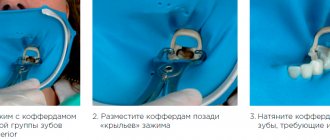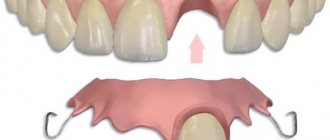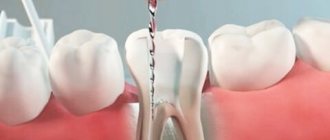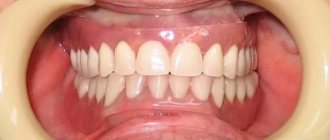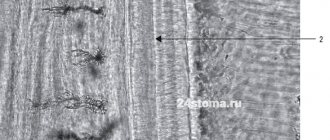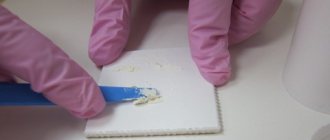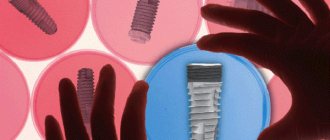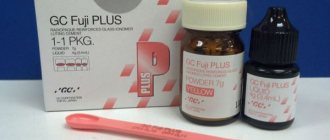The quality of modern adhesive restorations depends not only on their aesthetics, but also on the strength of the bonding component and their own adhesion to the remaining healthy tooth tissues. Such designs even make it possible to restore the previous hardness of the tooth, in particular, if you do not replace healthy tissue with material, but put it on top. Fixation is the most important stage of treatment, and therefore it should be given special attention. This article discusses the fixation of ceramic veneers using modern materials, taking into account their main advantages.
Clinical work was done by Mr. Daniele Rondoni, Styleitaliano, Savona (Italy).
initial situation
Rice. 1 Initial situation: several unaesthetic restorations that do not match the color of the tooth tissue
Rice. 2 You can see cervical caries on the lateral incisor and disproportion of all anterior teeth
Fig. 3 On the right, many defects are also noticeable, such as the opacity of tooth 11, previously treated endodontically and restored with a fiberglass pin, pigmentation of the proximal surfaces, and disproportionality of the teeth.
Rice. 4 The occlusal view is one of the most important aspects in planning veneer treatment. With its help, you can estimate how much restoration material will be needed and how much tooth tissue will have to be removed. In particular, in this patient, the central incisors need to be prepared sparingly (especially in the incisal area), whereas the lateral incisors do not require any preparation at all.
Rice. 5
Making a mock-up
Making a mock-up after wax-up allows you to see the long-term result of treatment. Usually, after approval of the proposed result, you can begin to dissect on top of the Mock-up. In turn, Wax-up is used at further stages of treatment:
1 – preliminary assessment stage;
2 – stage of assessing the depth of preparation;
3 – stage of manufacturing provisional structures;
4 – stage of final assessment of the restoration.
Preparing teeth for veneers
Pay attention to how little tissue was subjected to tooth preparation for veneers (visible from the silicone key). After preparation from the vestibular side, the remnants of the mock-up can be removed and the proximal and cervical surfaces can be processed.
Rice. 6
Rubber dam insulation
The veneers will be fixed one at a time in complete isolation of the working field. Details of rubber dam isolation of tooth 11: clasp 212 is used, adjacent teeth are also isolated for better access to proximal surfaces. The scope of the preparation performed is visible: the enamel of tooth 12 is intact, the central incisors are processed in the area of the cutting edge, the correction of cervical and proximal surfaces is carried out exclusively within the enamel. For better adhesion, the filling material on the surface of tooth 11 was sandblasted using 50 micron aluminum oxide particles.
Rice. 7
Relevance
Dental health cannot be considered in isolation from general health. Oral health is associated with the physical, mental and social well-being of individuals [1]. Impaired chewing function in humans is associated with activities of daily living, cognitive status, and depression [2]. The relationship between impaired chewing function and cognitive impairment has been scientifically proven, and problems with dental health are predictors of the development of depression [3, 4]. When assessing a person's quality of life, increased attention is paid to self-esteem and social interaction. Therefore, nowadays people are increasingly taking steps to replace missing natural teeth with dentures and observe the rules of individual oral hygiene [5].
The loss of natural teeth, including complete loss of teeth, is still an urgent problem in domestic and foreign health care, in the solution of which prosthetics with removable dentures play an important role [6]. At the same time, a large number of patients using removable partial and complete dentures complain about their unsatisfactory fixation and stabilization, and also have inflammatory processes in the mucous membrane of the prosthetic bed [7]. This is often caused by problems with psychosomatic health, especially in older and older people, due to the occurrence of hyposialia, which can be caused by both mental illness, somatic, including endocrine (diabetes mellitus), pathology, and the simultaneous use of several medications by the patient . A lack of oral fluid limits the holding capacity of removable dentures, and also contributes to the entry of food particles under the denture, injury to the mucous membrane of the denture bed and the development of denture stomatitis [8]. At the same time, patients using partial and (or) complete removable dentures rarely use adhesive agents for fixing dentures, which are currently available in the form of creams, pastes, strips, powders, as well as insoluble pads and pads. Many dentists cannot give patients clear and consistent recommendations on the care of removable dentures, as well as on the use of means for their fixation.
Because removable dentures, like natural teeth, can be subject to plaque and tartar buildup, it is recommended that you maintain your dentures daily to maintain your oral hygiene and overall health. Plaque and tartar that form on the surface of the base and artificial teeth of removable dentures negatively affect the dental health of the denture user. They promote infection of soft tissues, periodontal disease, and can lead to serious somatic pathology (pneumonia) [9]. However, among dentists there is no uniformity in recommendations for the care and storage of removable dentures, as well as for the use of means for their fixation by patients [10]. The lack of clear guidelines prevents denture wearers from effectively caring for them and using them most effectively. At the same time, there are scientifically proven recommendations for the care of removable dentures and the use of means for their fixation, which not only dentists, but also doctors of any specialty, especially geriatricians, should know.
The purpose of the work is to present recommendations for the safe use by adult patients of adhesive means for fixing removable dentures and means for caring for removable dentures, the knowledge of which is necessary for dentists of various specialties working with elderly and senile people.
Total etching
Total etching for 30 seconds using phosphoric acid.
Rice. 8
Rice. 9 In any technique for etching tooth tissue, the most important point is the complete removal of acid from its surface. To clean the tooth from all decay products of the etching agent, we recommend rinsing it off for 20 seconds. It is worth remembering that overdrying the dentin surface can lead to the collapse of collagen fibers, so it must be dried carefully. And if you need absolute dryness, you can always choose the self-etching technique.
Rice. 10 Clean matte tooth surface after the etching stage.
Rice. 11 At the same time, the feldspathic veneers were treated with hydrofluoric acid. Depending on the concentration, the acid exposure time changes: 1.5 minutes for 10% and 3 minutes for 5%. A sign of high-quality processing is the surface of the veneer - uniform, matte and clean. Otherwise, this stage should be repeated or (if the desired effect is persistently absent) sandblasting should be used.
Application of adhesive
Apply adhesive within 20 seconds using ScotchBond Universal, which can be used as either a self-etch agent or a total etch technique.
Rice. 12
Rice. 13 The next step is to distribute the adhesive with an air stream over the surface of the tooth so that its excess does not affect the fixation of the veneer.
Adhesive polymerization
Adhesive polymerization stage. Manufacturers recommend carrying out this process for 20-30 seconds, but it is better to increase this time to form a strong hybrid layer even in places farthest from the lamp.
Rice. 14
Rice. 15 The inner surface of the veneer must be treated first with silane (a substance that enhances adhesion), and then with an adhesive. In this case, the silane application step can be omitted, since it is present along with the phosphate monomer (MDP) in ScotchBond Universal. Both of these approaches (using silane before applying the adhesive or using only a silane-containing adhesive) have a scientific basis. In this case, we preferred to pre-treat the veneer surface with silane.
Rice. 16 Carefully distribute the adhesive with an air stream so that its excess does not interfere with the fixation of the veneer.
Rice. 17 The polymerization strategy is the same: increasing the time will improve the quality of the hybrid layer. Polymerization for one minute is justified only with a very thin layer of bond.
Zirconium dioxide veneers
Zirconium veneers are highly durable and can withstand the most severe loads. The microprosthesis frame is made from zirconium blocks and then covered with ceramic mass to achieve maximum naturalness and aesthetics of the veneers. One of the disadvantages of zirconium veneers is their high cost.
The cost of a zirconium veneer for one tooth in Moscow is 50,000 rubles.
Knowing the cost of one microprosthesis, you can estimate the cost of installing veneers on the teeth whose appearance you want to change. Typically, restoration with veneers is done only in the smile zone, which includes 10 upper teeth and 8 lower teeth. But the best way to find out how much dental veneers cost is to visit your doctor's office for an examination and diagnosis!
Price of ceramic crowns
Average cost of ceramic microprostheses:
- Emax solid crown – from RUB 13,000. for 1 unit;
- metal-free crown made of zirconium dioxide – from RUB 16,000.
This price does not include temporary plastic onlays (about 1000 rubles), as well as the removal of diagnostic impressions (from 800 rubles).
If you are looking for dentistry with affordable prices for prosthetics, we suggest looking at the list of clinics on our website. Just enter the desired city area into the search system.
Emax metal-free crowns
Emax dental crowns are made from solid porcelain (pressed ceramic). Porcelain is a material that is closest in composition to tooth enamel. Only single crowns, as well as veneers and inlays are made from it. The product is formed by injection molding under high pressure. Pressed ceramic contains a large amount of leucite crystals (minerals), which provides the highest strength.
Emax metal-free ceramics are the optimal option for implant-supported prosthetics.
Indications and contraindications
Indications for the use of metal-free ceramics include the following clinical cases:
- aesthetic disorders - chips, enamel defects, underdevelopment of the front molars, existing gaps in the frontal zone, distortion of the shape, the absence of one or more teeth, exposed and darkened neck;
- congenital anomalies of the dentition;
- replacement of outdated or worn restorations, broken fillings;
- severe damage to dental tissues caused by extensive caries;
- prosthetics in cases of allergic reactions to metal frame structures.
Contraindications to the use of metal-free ceramics:
- abnormal, deep bite;
- low clinical height of teeth (small teeth);
- the presence of acute conditions in chronic diseases;
- weakened immune system;
- pregnancy;
- frequently recurring attacks of bruxism (teeth grinding), leading to crowding, unevenness, and changes in the shape of the crown of the tooth;
- progressive osteoporosis;
- acute or chronic inflammation of the oral mucosa, periodontal disease, gingivitis.
Advantages
- unsurpassed aesthetic result (in addition to the above, there is also no dark stripe at the border of the crown and gum, which can spoil the smile when prosthetics of the front teeth are made with metal-ceramic structures);
- proximity of the material to natural teeth in terms of physical properties (thermal conductivity, expansion coefficient when heated, hardness, etc.);
- a metal-free crown is thin and light, does not require a large amount of tooth preparation (grinding), the patient quickly adapts to it (literally in a few days);
- harmlessness, complete biocompatibility - a metal-free crown is chemically inert, does not cause a galvanic effect, allergic reactions, intoxication, or irritation;
- durability (service life of at least 10 years), resistance to staining, darkening;
- comfort and ease of hygienic care.

